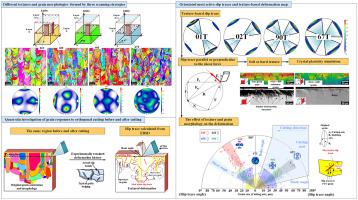International Journal of Machine Tools and Manufacture ( IF 14.0 ) Pub Date : 2023-06-17 , DOI: 10.1016/j.ijmachtools.2023.104050 Lingshan Li , Hao Chen , Zhirong Liao , Yue Yang , Dragos Axinte

|
In the laser powder bed fusion (LPBF), the grains grow in preferential directions depending on the scanning strategies, which results in layer-by-layer builds of particular crystallographic textures. The unique microstructure formed by LPBF results in anisotropic properties of the built structure at both macro and micro levels. To understand the grain deformation of the textured alloy fabricated by LPBF in the high-strain-rate shear process, Alloy 718 was used as an example in this work. Bulk samples with different metallurgical textures were deliberately fabricated by LPBF via three laser rotation angles, namely 0°, 67° and 90°, and then four thin slices obtained from bulks were subjected to “quasi-in-situ” grain deformation investigation through orthogonal cutting (a simple shear loading condition). The evolution of crystal orientations and morphologies, including size and shape, were traced before and after shear deformation. A full-field crystal plasticity simulation was used to quantify the stress status for grains obtained from EBSD data. This for the first time reveals the crystallographic level deformation history for hundreds of microns during a high strain rate shear removal deformation. Due to the carefully retained deformation history (i.e., typical bulges and slip bands) on the surface, a repeated deformation pattern was observed, attributing to the non-homogeneous deformation of typical build-directional blocks. The most active slip trace of deformed grain was calculated and verified based on the dominated slip bands within individual grains. The slip trace direction and intensity were quantified for different textured Alloy 718. Since the slipping-based deformation for an orientated grain is represented by its most active slip trace, a deformation tendency map is obtained by combining the shear direction, slip system and grain morphology. It reveals that grains in high texture intensity workpieces generally follow the macro shear-based deformation, while with the decrease in texture intensity, the plastic anisotropy is significant at the grain scale. Grains with similar orientations may also result in localised deformation anisotropy due to the different morphologies.
中文翻译:

激光粉末床熔合织构合金718正交切削过程晶粒变形研究
在激光粉末床熔合 (LPBF) 中,晶粒根据扫描策略沿优先方向生长,从而逐层构建特定的晶体结构。LPBF 形成的独特微观结构导致建筑结构在宏观和微观层面上具有各向异性。为了了解 LPBF 制造的织构合金在高应变率剪切过程中的晶粒变形,本文以合金 718 为例。通过LPBF故意通过0°、67°和90°三个激光旋转角度制备具有不同金相织构的大块样品,然后通过正交法对从大块获得的四个薄片进行“准原位”晶粒变形研究切割(简单的剪切载荷条件)。追踪剪切变形前后晶体取向和形态(包括尺寸和形状)的演变。使用全场晶体塑性模拟来量化从 EBSD 数据获得的晶粒的应力状态。这首次揭示了高应变率剪切去除变形过程中数百微米的晶体级变形历史。由于表面上仔细保留的变形历史(即典型的凸起和滑移带),观察到了重复的变形模式,这归因于典型构建方向块的非均匀变形。根据单个晶粒内的主导滑移带,计算并验证了变形晶粒最活跃的滑移迹。对不同织构合金 718 的滑移痕迹方向和强度进行了量化。由于定向晶粒的滑移变形是由其最活跃的滑移轨迹来表示的,因此结合剪切方向、滑移系统和晶粒形态可以得到变形趋势图。结果表明,高织构强度工件中的晶粒通常遵循宏观剪切变形,而随着织构强度的降低,晶粒尺度上的塑性各向异性显着。具有相似取向的晶粒也可能由于不同的形态而导致局部变形各向异性。结果表明,高织构强度工件中的晶粒通常遵循宏观剪切变形,而随着织构强度的降低,晶粒尺度上的塑性各向异性显着。具有相似取向的晶粒也可能由于不同的形态而导致局部变形各向异性。结果表明,高织构强度工件中的晶粒通常遵循宏观剪切变形,而随着织构强度的降低,晶粒尺度上的塑性各向异性显着。具有相似取向的晶粒也可能由于不同的形态而导致局部变形各向异性。



























 京公网安备 11010802027423号
京公网安备 11010802027423号